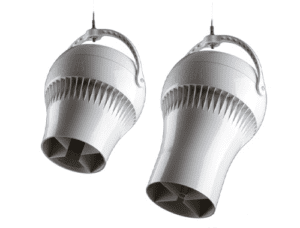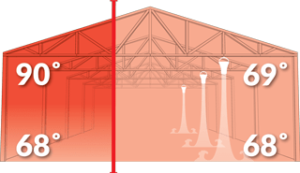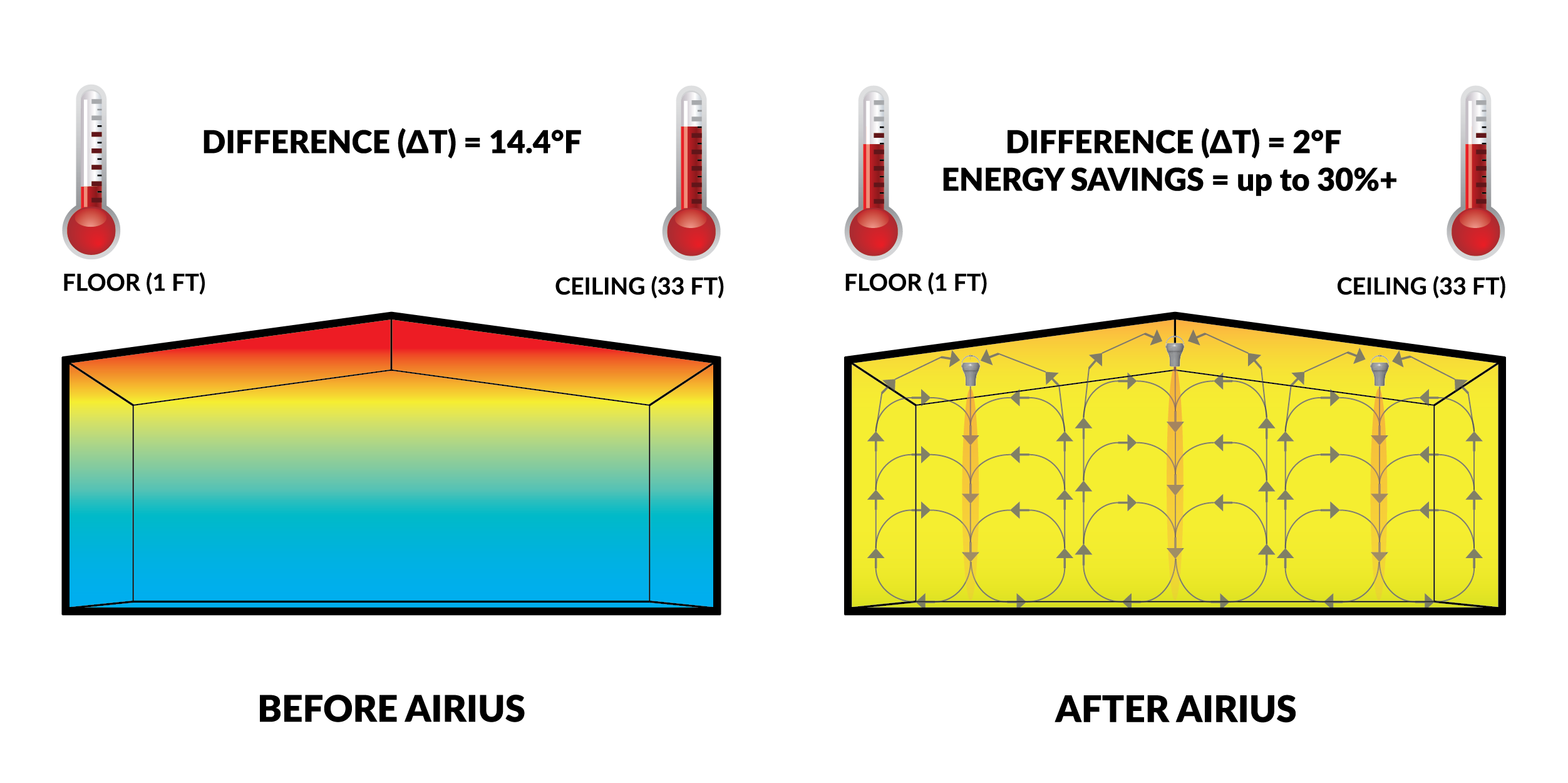How to Save Energy in Commercial and Industrial Spaces with a Destratification Fan
What are destratification fans?
Destratification fans are used to circulate air and reduce the temperature difference between the highest and lowest points in a building. Through this process, they can reduce the strain on a heating system, help distribute heat more evenly, move hot air away from the roof and toward the occupied floor of the controlled area, and minimize energy consumption. Balancing the room temperature can save energy and money and improve the comfort of occupants.
How do destratification fans work?
Destratification fans work by reversing the natural process of thermal stratification in which hot air rises and accumulates at the ceiling. These fans effectively redistribute the warm air from the ceiling down towards the floor, mixing the air in the space to achieve a more uniform temperature distribution throughout the room or building. This not only improves comfort levels but also enhances energy efficiency.
By pushing the warmer air down to occupant level, destratification fans reduce the need for additional heating, thus saving on energy costs. These fans are particularly useful in spaces with high ceilings like warehouses, industrial facilities, and large commercial spaces, where thermal stratification can be a significant issue. They are designed to operate quietly and efficiently, often with variable speed controls to optimize performance based on the specific needs of a space or to respond to changing conditions.
But won’t fans make it feel cooler?

Some destratification fans may cause a cooling effect in the immediate area beneath, therefore it is important to select the appropriate product to gently and precisely move air where it is needed such as an Airius fan. The fans help by balancing air temperatures throughout a space, which reduces the amount of energy needed to keep the space at a certain temperature at the occupied level.
By equalizing temperatures throughout an area, heat is not wasted on areas already at their desired level. Using destratification fans, businesses can save money on energy costs while keeping their spaces comfortable for employees and customers.
How much money can be saved?
Using destratification fans can save up to 20%-30% on heating costs. They are an increasingly popular way to save energy in commercial buildings and work to reduce the amount of heat that is trapped at the top of a building, known as stratification. Studies have shown that these fans can help save up to 20%-30% on heating costs. This makes them especially useful for businesses and other organizations looking to cut down on their energy expenses. And they increase comfort levels by reducing drafts and temperature fluctuations, making it easier for people to stay comfortable inside a building without having to adjust the thermostat too often.
If you have a warehouse check out our article on Warehouse Heating Bills Too Expensive?
Temperature Difference
Destratification fans are suspended from the ceiling and work by creating an even distribution of air throughout commercial and industrial spaces. Warm air rises toward the ceiling and cool air sinks toward the floor. The fans work to reduce the temperature difference between the ceiling level and lower levels of a building while also reducing energy consumption. 
It is generally accepted that in rooms with stratified air, the temperature differential is typically 0.5 to 1°F for every 1 ft of room height. This is significant in tall buildings like warehouses, car dealership showrooms, and office building lobbies because their ceiling height is greater than normal.
People in the building generally spend their time at floor level sitting or standing. The area where most people want to feel comfortable is between 0-6 feet above the floor, the occupied zone. Any energy used to heat the air above this point is wasted and increases the cost of heating or cooling.
Benefits of Destratification
Cost Savings
It is estimated that installing destratification fans can result in energy savings of up to 20%-30%, which translates into potential cost savings of hundreds or even thousands of dollars, depending on the size and scope of the commercial or industrial space. The Carbon Trust estimates that the use of destratification fans in industrial buildings with high ceilings can reduce energy consumption by 20%.
Using destratification fans also reduces costs by lowering wear on the HVAC system making it easier for occupants to live in comfortable conditions with less effort. Having a balanced room temperature reduces variations and allows your HVAC system to run at its optimal loading. When the room temperature is out of balance the system will have to run longer and harder, and often overheat the space to satisfy the temperature at the occupied level. And people in the room will notice the warm and cool spots in the room. With destratification fans installed the balanced room will be a lower load on your system.
The main benefit of using destratification fans is that they can help to reduce energy costs, improve air quality, and create a comfortable environment. In this article we show the benefits of destratification fans and how they helped lower energy costs by over 33%, Save Last Cold Storage Facility 42000.
Additionally, they can increase worker productivity through increased comfort as well as reduce condensation on glass.
Reduced maintenance costs: Destratification fans are easy to maintain and require little to no maintenance
Destratification fans are easy to maintain because they do not require frequent adjustments or interventions. They have a long lifespan, which means that once they have been installed and set up correctly, regular maintenance is not necessary. Additionally, these fans are designed to be energy efficient and durable so any investment in them will pay off in the long run with reduced energy consumption and increased comfort levels within the building.
For more information about saving money with destratification fans read our article Hidden Savings Evaporative Cooling or this article titled My Commercial HVAC Runs Constantly, Help!
Improved air circulation creates a healthier environment for a room
In addition to energy savings, these fans can also improve air circulation and help create a healthier environment by removing stale and stagnant air. The additional air circulation helps the building move pollutants, pollens, germs to the return filter without additional load on your system or cost.
By redistributing the heat more evenly throughout a space, employees can feel comfortable while working and be more productive. Destratification fans are an effective way to achieve this as they allow for efficient air movement so that all areas of the space receive adequate airflow during both heating and cooling cycles.
What you need to know about destratification fans?
Destratification fans are designed to address issues of uneven heat distribution in spaces with high ceilings by mixing the air. They effectively reduce the temperature difference between upper and lower air levels, leading to energy savings and a more comfortable environment.
When considering the purchase of destratification fans, here are key factors to take into account:
1. Size and Type of Space: The effectiveness of destratification fans depends heavily on the size and type of the space. Large commercial or industrial spaces with high ceilings benefit the most. Assess your space’s dimensions and layout before choosing.
2. Ceiling Height: The effectiveness of these fans generally increases with ceiling height, as there is more room for heat to rise and create stratification. They are most effective in buildings with ceilings over 15 feet high.
3. Fan Type and Design: Choose a design that fits the space and the aesthetic requirements. Some models are designed to be more visually appealing for customer-facing areas.
4. Velocity Profile: The capacity of the fan to move air over a long distance is crucial. If you are unable to mix the air from ceiling to floor, then the fan is not doing its job. Make sure to select a fan specifically designed for long throw and confirm performance through a velocity profile and not CFM alone.
5. Energy Efficiency: Look for energy-efficient models that utilize EC motor technology to maximize cost savings in the long term. Efficient destratification fans can significantly reduce heating costs by optimizing temperature distribution.
6. Noise Level: Especially important in retail, office, or other settings where noise can be a disturbance, choose fans that operate quietly while still being effective. Often you can upsize the fan and slow it to reduce noise levels.
7. Ease of Installation and Maintenance: Consider how easy the fan is to install and what ongoing maintenance is required. Some models are designed for easy install and low maintenance, which can save time and money in the long run.
8. Adjustability and Control: Features like adjustable fan speeds or ceiling and floor sensors can offer more control over air distribution and energy usage. Look for models that can easily integrate into your existing heating and ventilation systems for optimal control.
9. Warranty and Support: A robust warranty and readily available customer support can protect your investment and help address any issues that arise.
10. Cost: While initial cost is a consideration, think about long-term savings from reduced energy bills due to improved efficiency. Cheaper units may fail prematurely and accessing the ceiling can often times be very expensive and disruptive to operations.
Considering these factors before purchasing destratification fans can help ensure you select the right model for your needs, leading to improved comfort, energy efficiency, and cost savings.
Conclusion
In conclusion, destratification is an effective energy reduction strategy that helps promote more efficient use of resources. It can help businesses save money while being environmentally friendly at the same time. It also creates a better working environment, as air circulation is improved, and temperatures are kept at a comfortable level. Companies should explore destratification if they are looking for ways to reduce their energy bills and improve their workplace conditions.
Discover more about lowering your energy costs and increasing workers’ comfort. Our team is available to answer any questions you have. Contact us today.
Comments are closed.



